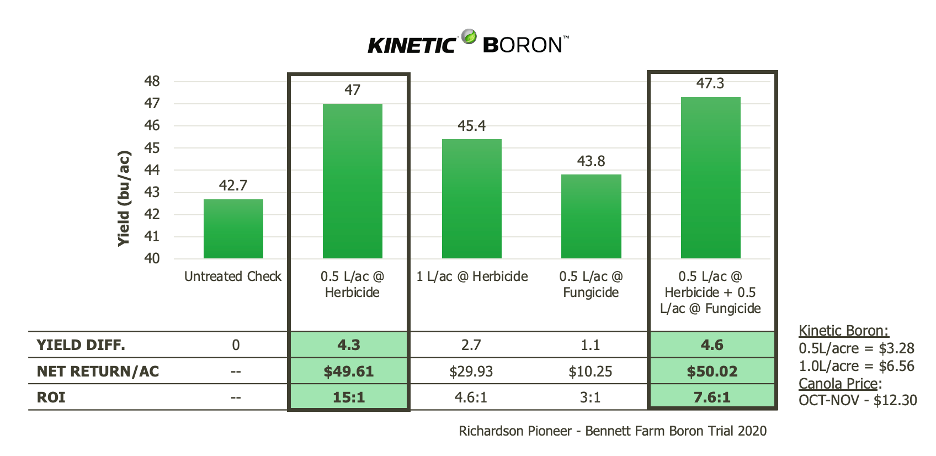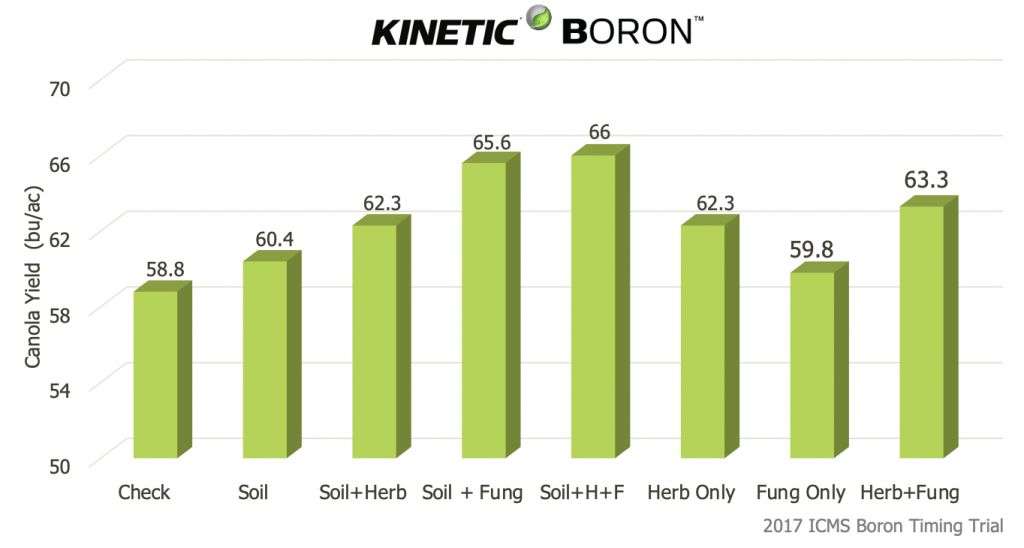Not only is boron deficiency one of the most prevalent micronutrient deficiencies around the globe – it’s one that can have a huge impact on yield.
We must proactively address boron deficiency to preserve the yield potential of the crop. But what is the most effective way to supply boron to the crop and what application provides the most return on a grower’s investment? Research at Bennett Farm last summer addressed these exact questions.
OBJECTIVE:
Kinetic Boron was applied to canola at two application timings (herbicide and fungicide) and at two different rates, to evaluate:
- Whether application timing of foliar boron fertilizer impacts canola yield and canola tissue boron levels.
- Whether application rate of foliar boron fertilizer impacts canola yield and canola tissue boron levels.
(See full trial design and background at the end of the blog)
RESULTS:
Impact of application timing of foliar boron fertilizer on canola yield
The results of the trial showed a yield increase following any foliar application of boron compared to the untreated check, regardless of the rate and when it was applied.
The highest yield advantage was observed when there was an application at herbicide timing.
The small yield advantage observed from the application at fungicide timing only, could suggest that waiting until fungicide timing to apply boron, could be too late to proactively address a boron deficiency.
However, when the crop had a boron application at herbicide timing, paired with a boron application at fungicide timing, that is where the yield advantage was highest.

Impact of application timing of foliar boron fertilizer on tissue boron levels
Tissue tests were performed twice throughout the season – on June 25th, and July 16th – to evaluate the how the different applications of boron impacted boron tissue levels.
The results of the tissue test performed on June 25th suggest that the lower application rate of 0.5L/acre at herbicide timing was just as effective, if not more, as the higher application rate of 1 L/acre of Kinetic Boron. But as expected, both applications resulted in higher boron tissue levels than compared to the untreated check.
Tissue Test – June 25, 2020

The results of the tissue test performed on July 16th showed that there were higher levels of boron in the crop treated with 0.5 L/ac of Kinetic Boron at herbicide timing than compared to the untreated check, even one month after application – suggesting there are lasting effects from boron applied at herbicide timing.
For the fungicide timing application of 0.5 L/ac of Kinetic Boron, the tissue test was performed six days after application. The results showed that boron levels in the plants treated with Kinetic Boron was more than double compared to the untreated control.
Tissue Test – July 16, 2020

Lorem ipsum dolor sit amet, consectetur adipiscing elit. Ut elit tellus, luctus nec ullamcorper mattis, pulvinar dapibus leo.

HOW THESE RESULTS FIT INTO THE BIGGER PICTURE
The findings of the 2020 Bennett Farm Boron Trial reinforce results from earlier research performed by ICMS. The results of the 2017 ICMS Boron Timing Trial below, show similar yield advantages to the Bennett Farm research when boron was applied at herbicide timing. However, this research also shows how going in early with a soil application of boron and pairing that with a foliar boron application can result in an even higher yield advantage over the untreated check.
When a soil application of Kinetic Boron was paired with fungicide application or both herbicide and fungicide application of boron, they observed more than 6.8 bu/ac advantage!

RECOMMENDATION:
Go early – Including a soil application of boron can increase yield even more than just a boron application at herbicide or fungicide timing.
Go often – Best results are observed when the crop is “spoon fed” throughout the season.
Best options to proactively address boron deficiency:
- A soil application followed by a foliar application
- If you can’t get in for a soil application, do two foliar applications – One at herbicide timing followed by an application at fungicide timing.
BACKGROUND
- Product Evaluated:
- Kinetic Boron (8%) (10B + Transit-S)
- Application Timing:
- Herbicide application was conducted on June 11, 2020
- Fungicide application was conducted on July 10, 2020
- Canola Hybrid: L345P
- Soil conditions:
- Soil boron levels: 1.3 ppm in 0-6” depth (1.21-1.60 ppm = high)
- Soil potassium levels: 751 ppm in 0-6” depth (>160 ppm = high)
